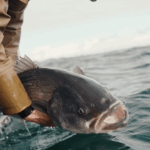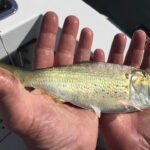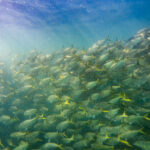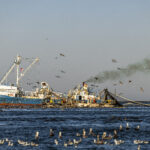
Release Mortality Revisited: New Research from Massachusetts DMF
Feature Photo Credit: Robbie Tartaglia What’s going on? For decades, striped bass management relied on a
Tony Friedrich VP/Policy Director ASGA
Let me warn you ahead of time, this is a long article. But, you care about striped bass so read the whole thing.
Conservation equivalency (CE) allows states/jurisdictions (hereafter states) flexibility to develop alternative regulations that address specific state or regional differences while still achieving the goals and objectives of Interstate Fishery Management Plans (FMPs).
The concept itself isn’t terrible. When you compare the striped bass fishery across the migratory path, there are vast differences in the size and distribution of the species. The guidance document for CE is also not terrible on the surface. It covers background, guidance policy, proposal standards, and a review process.
CE represents the “flexibility” and state management that many tout as the way forward for fisheries management. ASGA has advocated against flexibility and state management since our inception. As state leadership changes, wild swings in policy can be expected.
This is why ASGA believes that CE is not an ideal option for overfished, migratory stocks. Saltwater migratory fish, like striped bass, visit many states and we feel that consistent management is the only way to create a sustainable fishery. We would like to be able to plan our businesses out three to five years. Currently, we can’t depend on anything year after year.
At the ASFMC meeting in late October, Capt John McMurray made a motion to not allow CE for striped bass as long as the stock is overfished and overfishing is occurring. The motion got a second from Commissioner Abbott in New Hampshire but failed to gain momentum.
We will never have a true slot limit for striped bass as long as CE is an option. If you believe slots would work for striped bass, CE is not your friend. We have a current max size recommended through ASMFC. With CE in place, you can bet your last dollar some states will propose regulations without a max size. So, it isn’t a slot if 50″ fish can still be harvested in certain states.
Three states have come forward with a fairly reasonable application for CE. CT, NY, and RI are considering moving forward as a block. Here is the proposal they are weighing.

All three states fish around Block Island. If they don’t agree on matching regulations, things will get very confusing. Option A, all modes 30-40″, was the overwhelming winner at the meeting in Rhode Island early this week. We are against sector separation and feel the entire recreational community should be treated equally. This proposal will take the pressure off the few giant striped bass left that frequent areas surrounding Block Island.
We applaud these states for considering this alternative.
Leave it to New Jersey to suck the air out of the room. New Jersey is basically flip flopping their bonus tag system. Here’s a look at their proposals.

New Jersey is looking to have a new size limit of 24-28 or 29″ with the bonus tag going to a big fish, either 35″ or 43″ minimum. Last year, the size limit in New Jersey was 28 to 43″ with another fish over 43″. From Sept 1 to Dec 31, New Jersey anglers could harvest another fish (3 total) between 24-28″.
The 2015 year class will be around 24″ in 2020. Crazy how that works isn’t it? A state lowering the size limit to crush the last hope we have for a good year class to recruit to the spawning stock biomass.
For those that don’t know, CT just suspended their bonus tag system. Bonus tags in CT and NJ are basically a transfer of quota between the commercial and rec sectors. Commercial striped bass fishing is no longer allowed in either state. So, the quota was transferred to the rec sector in the form of bonus tags.
For years, we have heard this was a great system and New Jersey had to use it or another state that allowed commercial fishing would take the quota. Well, that isn’t allowed or outlined in the Fisheries Management Plan. If it was possible, how could CT suspend it?
The New Jersey bonus tag quota is 215,000lbs. With and 18% reduction, the new quota will be about 176,000lbs. How far is that going to go at 43″ a fish? That won’t take very long for several reasons. First, it looks like New Jersey will be one of the only states that harvests larger striped bass. So, expect additional business from out of state clients that just have to kill that 50″ fish. Second, we aren’t 100% sure of the season for bonus tags. In the spring or fall 176,000lbs of fish could be harvested in a matter of days.
The track record of previous years bonus tags is unsettling to say the least. About 5000 were applied for in 2018 and only 1100 were returned. Are you honestly trying to tell us that from September to December 31st, only 1100 fish were harvested between 24-28″ in the entire state of New Jersey?
Seems like there are some serious reporting issues with bonus tags. New Jersey has an enormous number of anglers combined with access that is second to none, a robust charter and party boat fleet, and private boat anglers that number in the hundred of thousands.
Like we have said all along, we will never have a slot limit as long as CE exists. New Jersey still has a process to go through. The image you see is a suite of proposals. None of them look good. The state jumbled numbers to take advantage of the 2015’s while still killing big fish based on an unaccountable system that can and should be suspended.
The worst possible use of CE is unfolding in Maryland. Maryland has several proposals out there that were created to allow segments of the community to take almost no reductions while laying the bulk of the restrictions on a specific stakeholder group.
The full proposal can be found here. Let’s take a moment and break this down for people not familiar with the Maryland fishery.

The graphic is a little hard to read. Option 4 seems to be the front runner so we will focus on those options. As we take you through this CE proposal, you need to understand that ASMFC’s suggested option for the Chesapeake Bay was 1 fish @ 18″. 84% of the comments came in for 1 fish @ 18″. You can’t get 84% of the public to agree on what color the sky is. Seems like we are safe calling this a mandate.
Rather than keep it simple, Maryland has spent the last few months directing staff to find every possible way to allow large charter boats to continue to harvest because if they can’t kill two fish, they will all go out of business. That’s the story anyway. This is a gigantic waste of budget for DNR. We have lost weakfish, flounder, bluefish, and croaker. Yet, DNR is spending resources on how to allow certain segments to not take any cuts.
What you see above is the fruit of their labor. The first section calls for a no targeting closure in April. That means no catch and release. This achieves only a .66% reduction and keeps a bunch of guides and private anglers off the water. On May 1, trophy season starts. That means 1 fish at a 35″ minimum. It is terrible to catch and release fish in April but perfectly fine to kill them starting May 1. The logic is lacking.
Why would DNR do this? Well, the answer is pretty simple. The guys who like to kill fish during trophy season have the political power right now and hate the guys who catch and release before trophy season starts.
About ten years ago, a recreational fisherman posted on a popular forum that he ran a twenty plus rod trolling spread through a gannet storm during preseason. He ended up hooking over twenty stripers.
It is pretty dumb to do and it doesn’t happen often but it was the catalyst for a six month long assault on preseason catch and release. Maryland DNR did the science and found that during all of catch and release season, from January 1- the 3rd weekend in April (Trophy Season), only 900 fish were killed via catch and release. That isn’t a lot of fish.
DNR changed a few regulations for the better. They limited the amount of trolling rods to 6 and banned stinger hooks for the preseason. That makes sense. With those regulations in place, you can bet that that 900 number is even lower.
Most of the folks who participate in preseason catch and release are using single hook, artificial lures. This is true in the mainstem of the bay as well at the Susquehanna Flats. The flats are the most studied fishery in Maryland. It closes when the water gets too warm. It is highly regulated and 100% release. It is a clean fishery. Most fish caught are males staging to spawn.
The .66 reduction is based on the standard 9% release mortality applied to striped bass. Shouldn’t we be using the best science we can when managing a fishery? I ask this because we know that in the spring on the Flats, release mortality is actually .8%.
The reality of a spring closure is that numbers are being inflated so one sector and keep killing two fish. If the Technical Committee at ASFMC isn’t aware of the science, we would be happy to send it to them. It was conducted by MD DNR in the late 90’s. In fact, we are friends with the retired biologist that headed up the study.
Here’s the kicker. The MRIP numbers being used to estimate the spring closure numbers aren’t solid. Three of the last five years have a PSE of 50% or greater. The PSE is the Percent Standard of Error. It is a measure of precision that expresses the standard error of an estimate as a percentage of that estimate. When the PSE goes over 30%, NOAA red flags it as unreliable. At least NOAA is being transparent about the validity of the data.
We aren’t sure why the TC would take this seriously. For March/April in Maryland inland waters, the PSE for 2016 was 50.6, 2017 was 40.1, 2018 was 57.1 and the preliminary numbers for 2019 are 64.5. You would have better luck playing three card Monty in Times Square circa 1989 than you would relying on this information.
MRIP is not great at drilling down to specific waves for specific years. In other words, finding out how many fish are released in a two month period in one year is not the strength of the program. The 2017 and 2018 estimates for March/April were around half a million fish caught and released each year. The 2019 numbers suggest under 80,000.
There is a lack of data for March and April in Maryland. If you are wondering why MD DNR didn’t try to squeeze another tenth of a percent by closing January and February, it is because there is no data for January and February.
Let’s go to the next section that says no targeting of striped bass for 15 days in August. Just like the previous section, we are going to shed some light on the fishery in Maryland during the summer.
We wrote an article on catch and release mortality that shows warm water, salinity, and air temp are interactive in release mortality. The biggest factor in mortality is salinity. The average salinity in the bay varies widely from Tangier Sound to North of the Bay Bridge. The further south you go, the higher the salinity. It takes just a minimal amount of salinity to dramatically decrease release mortality.
We are not opposed to closures that make a difference. However, closing fishing in clean water with dissolved oxygen and salinity makes absolutely zero sense. Maryland should be breaking the Chesapeake into zones. Freshwater zones should be no target areas during the hottest months in the summer, not for 15 days. That would make a huge difference.
However, the one last decent school of fish has been located around the mouth of the Chester River, north of the Bay Bridge. The charter community up there won’t tolerate a longer run to catch fish in better water.
We would hope that the Technical Committee understands that it is almost impossible not to catch stripers when fishing for other species in the bay. You will encounter small stripers mixing with schools of white perch, the number one other target of fishermen in tidal waters. You will encounter stripers fishing for catfish, speckled trout, spanish mackerel, and bluefish.
Just saying “no targeting” is absurd. You can’t avoid small stripers and that’s a fact. How is this enforceable?
That’s a great segue to our final point on this proposal. Throughout the normal season, the charter community can keep two fish if they participate in electronic reporting while the rest of the recreational community can keep just one. How does electronic reporting help lower harvest? Well, it doesn’t. So the charter community can fill out a form and continue their status quo of killing two fish in dirty, low oxygen, fresh water even though every single shred of science says this is bad? We thought this was a catch and release mortality issue? Wouldn’t going to one fish help that considerably? Is a 15 day closure in August really going to help as the fleet mows through undersized fish drunk on chum to get that second keeper throughout June, July, half of August and the first few weeks of September?
Some have suggested this is an accountability issue and private anglers are being punished for their lack of good data. Well, in the winter of 2009-2010 illegal gill nets (anchored not drift) were found in the bay. One net had 16,000lbs of striped bass.
Instead of going after the commercial fishermen, we advocated for a better management system. The commercial striped bass fishery went from a Wild West Derby to an accountable ITQ system under the guidance of Tom O’Connell, the previous Fisheries Director for MD DNR.
Because of the ITQ system, you don’t see poaching in the commercial sector anymore. The quotas are well managed. The community embraced ITQ’s and are able to run their businesses properly. That’s a textbook case of addressing a problem and coming out on the other side with accountability.
Why aren’t private recreational anglers given the same opportunity to be accountable? Why aren’t they offered some form of electronic reporting like the charter for hire community? Knowing the private fishing community well, I would say the concept would be met with appreciation from them.
This is what it all comes down to. Have a closure in the spring, when release mortality is .8%, a 15 day closure with no targeting that won’t do anything, and a one fish limit all year for private anglers just so one tiny segment of the fishery can kill two fish. The proposal might look good on paper but it won’t restore striped bass.
We also know that if the CE proposal is rejected, Maryland will plan to go out of compliance. Yup, that’s how far the state is willing to go to give entitlements to a group that numbers less that 500. We strongly oppose this sector separation. It is unfair and solely designed for the smallest segment of the recreational community to kill striped bass in the worst conditions possible.
The real threat is that like it or not, the Chesapeake produces over 70% of the stripers you catch up and down the coast. If certain segments are allowed to continue a harvest level that overfished by 220%, how can we expect striped bass to recover? We aren’t sure how inputting data is going to stop that if the regulations don’t change for all.
The mission statement of Marlyand DNR is:
The Department of Natural Resources leads Maryland in securing a sustainable future for our environment, society, and economy by preserving, protecting, restoring, and enhancing the State’s natural resources.
No where in that statement can we find that it is MD DNR’s job to pick winners. These proposals do absolutely nothing to preserve, protect, restore, or enhance the striped bass population. The proposal is designed to allow a few to continue harvesting and penalize businesses and private anglers that rely on and practice preseason catch and release.
This is why we are opposed to CE. This proposal will hinder the ability of striped bass to recover. It entitles a select few to kill fish at a rate that caused overfishing 11 of the last 13 years. It takes months of income away from the few guides left on the bay. It hurts private anglers who can’t afford the $1000 plus fee to book a charter.
We implore MD DNR to abandon these proposals and adopt 1 fish @ 18″. We know that catch and release mortality was a red herring to continue harvest. This proposal proves that. 1 fish @ 18″ would have kept it simple, solved release mortality, and been easy to enforce. We hope this article sheds some light on the issue and the states who are doing the right thing oppose this proposal at the ASMFC meeting in February. CE should not be allowed for overfished stocks! Any state that applies for conservation equivalency should be subject to payback provisions if they overfish. There is zero accountability in all of this and it makes us sick.
In conclusion, we wonder what it will take for the other states to actually stand against New Jersey and Maryland? The two states that are the most important for striped bass recruitment spend countless hours making numbers work on paper so they can demolish the stock on the water. Maine, New Hampshire, Massachusetts, and Virginia have not applied for CE. Connecticut, Rhode Island, and New York may very well use CE in a good way. What will it take for these states to vote against Maryland and New Jersey for the harm they will cause to the stock we all share?

Feature Photo Credit: Robbie Tartaglia What’s going on? For decades, striped bass management relied on a

Recent developments in the 2025 Atlantic Menhaden Stock Assessment Update, released by the Atlantic States

What’s going on? The “most important fish in the sea” just exposed one of the

Mario CampoFisheries Ecologist, Southeastern Louisiana UniversityScience and Policy Associate, American Saltwater Guides Association This discussion
We rely on our members and donations to keep fighting for a sustainable tomorrow in marine conservation.
GIVE THE GIFT OF FISHERIES CONSERVATION THIS HOLIDAY SEASON. SHOP ASGA GOODS THAT FUND FISHERIES RESEARCH & ADVOCACY CAMPAIGNS
JOIN ASGA IN CALLING FOR CRITICAL MANAGEMENT ACTION AFTER YEARS OF SPAWN FAILURES & POOR MANAGEMENT.
By using this website, you agree to our use of cookies. We use cookies to provide you with a great experience and to help our website run effectively. To learn more, please review our privacy policy.
7 Responses
Say the ASMFC does the right thing and rejects these egregious CE proposals – you mention MD would then decide to go “out of compliance”. What are the repercussions to that?
I’m truly hopeful that the new chair of the ASMFC does the right thing here. If he allows these to pass, he is essentially saying that once again the ASMFC is a useless, inept committee that can be bought.
Patrick, non-compliance would start the same process we just went through with menhaden. It would further fracture fisheries policy and cause critical resources to be shifted to yet another battle at the commerce department.
Not disagreeing with the overall sentiment here surrounding CE and its mis-use but there are a few things that stand out to me. One is using the data that supports your agenda and and casting off the data that does not. As long as we get to pick and choose what data points we accept there are plenty of questionable studies and data we could refute. Second is this notion that keeps getting put forward about how commercial watermen in MD post ITQs are all of a sudden bastions of ethics and above poaching. Its very hard to believe you are ignorant of the games that are played with tags, and only clipping tags on fish when needed and the volume of fish that never get tagged. This speaks back to the data and how there is zero chance it is accurate regarding the various sectors, don’t get me wrong, striped bass are in decline, changes need to be made but right now all the various user groups, commercial, rec, LT guides, charters, party boats are saying to each other, “I’m not giving up anything, take it from the other guys”
Bob, we have never advocated for taking anything from one group and giving to another. If we have, please show us where.
In regard to the data, MRIP has a weakness. That weakness is data-poor waves for specific species on specific states. It was not designed to do this. It was designed for coast-wide estimates over time. We are not picking select data points. Poor data points with high pse’s are being used to push a position.
If you remember pre-ITQ days, you know the current system is a vast improvement.
I think my comment regarding ‘take it from the other guys’ was misinterpreted. Striped bass are in decline and here is the stance the various user groups have taken. The commercial entity says “We are only a very small part of the harvest (using the data as their ammo), we shouldn’t have to reduce any further, take it from the rec sector” The Charter boat industry says “Our businesses would not be viable with a 1 fish limit, why reduce us to 1 fish when its all the release mortality that is the problem (using the data as their ammo) , you need to reduce all the C&R effort” The Light Tackle C&R guides say “We aren’t the problem, all the fish we catch and release survive, just look at the data its a .08 release mortality in cold water and none of us would ever C&R in warm fresh water, you need reduce the party boat effort they are the real problem here. C&R should never be restricted for any time or any reason” The average rec fisherman says “I only get to fish a handful of times each year, I’m not the problem, look at all the fishing mortality from commercial industry, party boats and guides, you need to reduce them not me” In the end all the user groups are suggesting you restrict “the other guy” and so you end up with a CE proposal that looks the way it does.
In regard to ITQ, I’m not suggesting it was not an improvement but, what I am suggesting is that there is a gross false sense of security in those numbers.
Understood and we appreciate the clarification. Our position is to do what is best for the resource and everything works out. Using flawed wave data for the spring to continue practices that are detrimental to the stock during the summer is unacceptable for us.
As far as the commercial sector goes, yes there are loopholes being exploited. However, the high liners run their operations as a business and have far too much on the line to risk. That is what ITQ’s did. To us, that is very positive.
Appreciate the positive discussion…